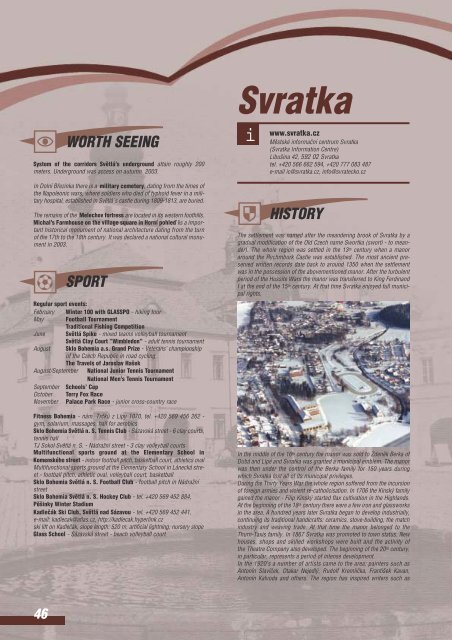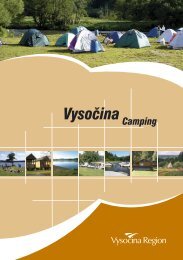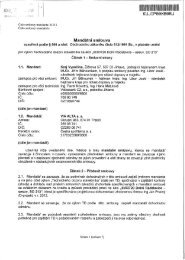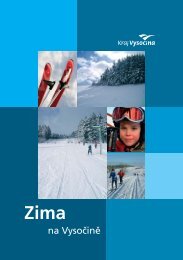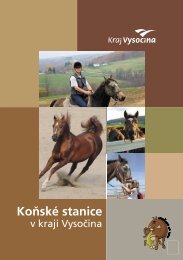history - Extranet
history - Extranet
history - Extranet
- No tags were found...
You also want an ePaper? Increase the reach of your titles
YUMPU automatically turns print PDFs into web optimized ePapers that Google loves.
WORTH SEEINGSystem of the corridors Svûtlá’s underground attain roughly 200meters. Underground was access on autumn 2003.In Dolní Bfiezinka there is a military cemetery, dating from the times ofthe Napoleonic wars, where soldiers who died of typhoid fever in a militaryhospital, established in Svûtlá´s castle during 1809-1813, are buried.The remains of the Melechov fortress are located in its western foothills.Michal’s Farmhouse on the village square in Horní pohleì is a importanthistorical monument of national architecture dating from the turnof the 17th to the 18th century. It was declared a national cultural monumentin 2003.SPORTRegular sport events:February Winter 100 with GLASSPO - hiking tourMay Football TournamentTraditional Fishing CompetitionJune Svûtlá Spike - mixed teams volleyball tournamentSvûtlá Clay Court ”Wimbledon” - adult tennis tournamentAugust Sklo Bohemia a.s. Grand Prize - Veterans’ championshipof the Czech Republic in road cyclingThe Travels of Jaroslav Ha‰ekAugust/September National Junior Tennis TournamentNational Men’s Tennis TournamentSeptember Schools’ CupOctober Terry Fox RaceNovember Palace Park Race - junior cross-country raceFitness Bohemia - nám. TrãkÛ z Lípy 1070, tel. +420 569 456 262 -gym, solarium, massages, hall for aerobicsSklo Bohemia Svûtlá n. S. Tennis Club - Sázavská street - 6 clay courts,tennis hallTJ Sokol Svûtlá n. S. - NádraÏní street - 3 clay volleyball courtsMultifunctional sports ground at the Elementary School inKomenského street - indoor football pitch, basketball court, athletics ovalMultifunctional sports ground at the Elementary School in Lánecká street- football pitch, athletic oval, volleyball court, basketballSklo Bohemia Svûtlá n. S. Football Club - football pitch in NádraÏnístreetSklo Bohemia Svûtlá n. S. Hockey Club - tel. +420 569 452 884,Pû‰inky Winter StadiumKadleãák Ski Club, Svûtlá nad Sázavou - tel. +420 569 452 441,e-mail: kadlecak@atlas.cz, http://kadlecak.hyperlink.czski lift on Kadleãák, slope length: 520 m, artificial lightning, nursery slopeGlass School - Sázavská street - beach volleyball courtSvratkaiwww.svratka.czMûstské informaãní centrum Svratka(Svratka Information Centre)Libu‰ina 42, 592 02 Svratkatel. +420 566 662 594, +420 777 083 487e-mail ic@svratka.cz, info@svratecko.czHISTORYThe settlement was named after the meandering brook of Svratka by agradual modification of the Old Czech name Swortka (sworti - to meander).The whole region was settled in the 13 th century when a manoraround the Rychmburk Castle was established. The most ancient preservedwritten records date back to around 1350 when the settlementwas in the possession of the abovementioned manor. After the turbulentperiod of the Hussite Wars the manor was transferred to King FerdinandI at the end of the 15 th century. At that time Svratka enjoyed full municipalrights.In the middle of the 16 th century the manor was sold to Zdenûk Berka ofDubá and Lipé and Svratka was granted a municipal emblem. The manorwas then under the control of the Berka family for 150 years duringwhich Svratka lost all of its municipal privileges.During the Thirty Years War the whole region suffered from the incursionof foreign armies and violent re-catholicisation. In 1706 the Kinsk˘ familygained the manor - Filip Kinsk˘ started flax cultivation in the Highlands.At the beginning of the 18 th century there were a few iron and glassworksin the area. A hundred years later Svratka began to develop industrially,continuing its traditional handicrafts: ceramics, stove-building, the matchindustry and weaving trade. At that time the manor belonged to theThurn-Taxis family. In 1867 Svratka was promoted to town status. Newhouses, shops and skilled workshops were built and the activity ofthe Theatre Company also developed. The beginning of the 20 th century,in particular, represents a period of intense development.In the 1920’s a number of artists came to the area: painters such asAntonín Slavíãek, Otakar Nejedl˘, Rudolf Kremliãka, Franti‰ek Kavan,Antonín Kalvoda and others. The region has inspired writers such as46


